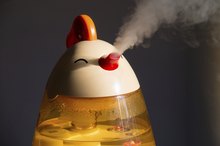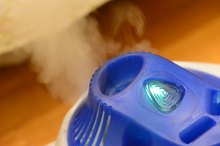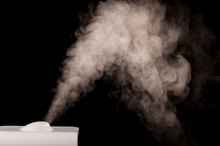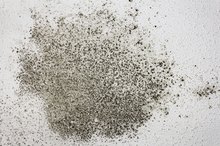Humidifier Mold Prevention
Humidifiers are used to help ease nasal and chest congestion due to allergies or the common cold, but if not maintained properly, they can lead to health complications, according to MayoClinic.com 1. Humidifiers create extra moisture in the air and can encourage the growth of mold and mildew. Mold and mildew are visible clusters of fungi that can cause allergic reactions or illness in people, according to the Air-Conditioning and Refrigeration Institute. Talk to a doctor if symptoms develop while using a humidifier.
If you are experiencing serious medical symptoms, seek emergency treatment immediately.
Types
Different types of humidifiers exist. Some are more likely to encourage the growth of mold and mildew. Warm mist humidifiers pose the greatest threat because they combine moisture with warmth. These two elements are the essential ingredients for mold growth. Other humidifiers include cool mist models and vaporizers. Cool humidifiers pose the greatest threat of producing mold within the unit, if not properly maintained, according to MayoClinic.com 1.
- Different types of humidifiers exist.
- Cool humidifiers pose the greatest threat of producing mold within the unit, if not properly maintained, according to MayoClinic.com 1.
Daily Maintenance
How Does a Humidifier Work on Congestion?
Learn More
National Jewish Health recommends that a user perform certain daily maintenance procedures to avoid mold growth 2. Empty the water reservoir and wash it in the sink with hot soapy water, or wash it in a dishwasher. Allow the reservoir to air dry.
- National Jewish Health recommends that a user perform certain daily maintenance procedures to avoid mold growth 2.
- Empty the water reservoir and wash it in the sink with hot soapy water, or wash it in a dishwasher.
Weekly Maintenance
Clean the entire unit on a weekly basis, while in use. Do not clean the machine in the presence of someone with a mold allergy or lung issue. Clean the reservoir with hot soapy water and rinse. National Jewish Health states that the user needs to sanitize the machine using white vinegar or a half bleach, half water solution. Add 2 cups of either solution to the water basin and run the machine for 30 minutes. Place water in the humidifier and run the machine for three minutes. Rinse out the reservoir and allow to air dry.
- Clean the entire unit on a weekly basis, while in use.
- Add 2 cups of either solution to the water basin and run the machine for 30 minutes.
Humidity Levels
Uses of Vinegar in Humidifiers
Learn More
One of the main concerns while running a humidifier is the humidity levels in the home. MayoClinic.com recommends keeping humidity levels between 30 and 50 percent 1. Measure the humidity in the home using a hygrometer, which you can purchase at a local hardware store.
Warning
Regular use of a humidifier is not recommended for people with allergies to mold or dust mites. A humidifier can encourage the growth of dust mites and mold, according to National Jewish Health, despite potential cleaning efforts 2. Talk with an allergist before implementing any treatment.
Related Articles
References
- MayoClinic.com: Humidifiers
- National Jewish Health: Mold Allergy: Proper Humidifier Care
- Medline Plus. Humidifiers and health. Updated October 11, 2018.
- Unsdorfer S. Cool mist humidifier: adding humidity where it counts. Central Heating & Air Conditioning.
- "Indoor Air Facts No. 8: Use and Care of Home Humidifiers." Indoor Air Quality. 24AUG2006. US Environmental Protection Agency (EPA).
- Pearl, MD, Alden J.. "Medical Encyclopedia - Sinusitis." Medline Plus. 11JAN2007. National Institutes of Health.
Writer Bio
Diane Marks started her writing career in 2010 and has been in health care administration for more than 30 years. She holds a registered nurse license from Citizens General Hospital School of Nursing, a Bachelor of Arts in health care education from California University of Pennsylvania and a Master of Science in health administration from the University of Pittsburgh.









